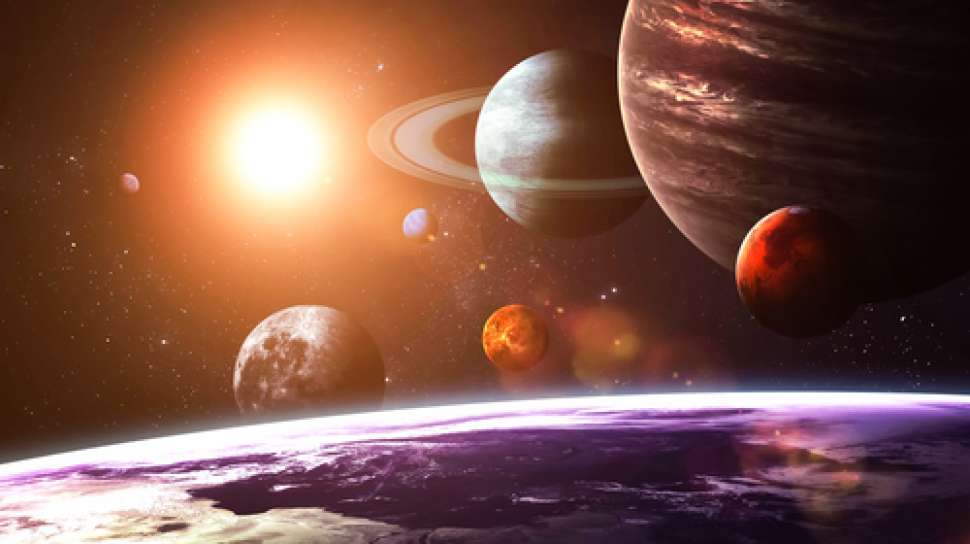Suara.com – When you look up at the star-studded night sky, have you ever thought about the origin of its formation? solar system?
The solar system is a collection of celestial bodies consisting of the sun and objects around it that are bound by gravity, including the earth.
Quotes Teacher’s Room, Wednesday (11/24/2021), there are at least 5 theory of the formation of the solar system, the details are as follows:
1. Nebula Theory
This theory cannot be separated from the figure of Immanuel Kant, who is not only famous as a philosopher, but also focuses on studying various sciences, ranging from geology, astronomy, to physics.
Also Read:
The Sun’s Original Color: If It’s Not Yellow, Then What?
In his 1755 work entitled “The Universal Natural History and Theories of the Heavens”, he proposed a theory explaining the origin of the solar system.
He argued that at first, the fog and gas in the sky rotated slowly and formed a flat disk with several mass nuclei.
The core mass in the center, has a high temperature and glows and forms the sun, while the core mass at the edges cools and slowly turns into planets orbiting the sun.
At that time, not only Kant who thought about how the process of the emergence of the solar system. There is also a French astronomer named Pierre Simon De Laplace who thinks about the origin of the formation of the solar system.
In his book “Exposition of a World System” (1796), Laplace gave his statement about the process of the formation of the solar system.
Also Read:
Biggest Comet Approaching Earth After 3.5 Million Years of Wandering
In contrast to Kant who thought that the solar system originated from a slowly rotating fog, Laplace argues that our solar system originated from a gas mist that rotates quickly and has very high temperatures.
The spinning speed of this gas mist, finally threw various gas balls of matter around him.
Over time, these solid balls turned into planets and the main source of the hot balls became the center of the orbit of the planets we know as the sun.
So, it can be concluded that the Nebula Theory is a theory which states that the solar system was formed from a thick and large fog that rotates, twists, and condenses into the sun and the planets and other solar system constituents.
2. Theory Planetesimal
This theory was put forward by Thomas C. Chamberlin and Forest R. Moulton in 1905. In this theory, Moulton and Chamberlin argued that at first, the sun was a star that had existed before the other components of the solar system formed, but at that time had not yet been decided. if his name is sun.
Then, once upon a time, another star the size of the sun passed by and orbited very close to the sun.
Furthermore, because this large star has gravity, as a result there is solar material that is pulled out.
Material that was not dragged away, managed to re-enter and rejoin the sun. However, material that is dragged far away ends up just floating in space.
Then, these floating materials gradually collect, coalesce, and harden so that they become various planets and other constituents of the solar system.
3. Tidal Theory
The tidal theory is similar to that of planetesimals. This theory was put forward by James and Jeffreys. In this theory, the sun is considered a star that already exists, it’s just that it hasn’t been decided if its name is the sun.
Next, pass a large star orbiting close to the sun. If in the planetesimal theory, the gravity of this large star attracts the sun’s materials, in the tidal theory, the gravity of the passing large star attracts a tidal wave of solar hot gases.
The waves of attracted solar gases then form filaments which eventually become the forerunners of planets and other constituents of the solar system.
4. The Twin Star Theory
This theory is quite ‘unique’ and different, put forward by Raymond Arthur Lyttleton, a British scientist in 1956. According to him, before the galaxy was formed, there were two ‘giant stars’ in outer space. That is why this theory is called twin stars.
Then, one of these two stars exploded and shattered into pieces of rock, gas, dust, and various other materials.
Then, the shards of the exploding star float around in space and slowly orbit towards the still intact star.
The fragments of the exploding star gradually became planets and other constituents of the solar system, while the intact (unexploded) star later became the sun.
5. Dust Cloud Theory
The Dust-Cloud Theory was originally coined by Carl Friedrich von Weizscker, then this theory was ‘refined’ again by Gerald Peter Kuiper.
Basically, they say that the solar system was formed from a huge mass of clouds and dust, which rotated like a disk, then changed shape into planets and the sun.
In the Dust Cloud theory, the process that occurs is compression or agglomeration. In this compression process, dust particles are attracted to the center of the cloud, forming a ball, and over time it becomes a disc.
Then, the particles in the center of the disc press against each other, creating heat and becoming incandescent. This middle part, then becomes the sun.
While the outside rotated very quickly, then it got to the point where they bounced off and split into smaller lumps.
It is this part that eventually becomes the planets and other constituents of the solar system besides the sun.
– .


